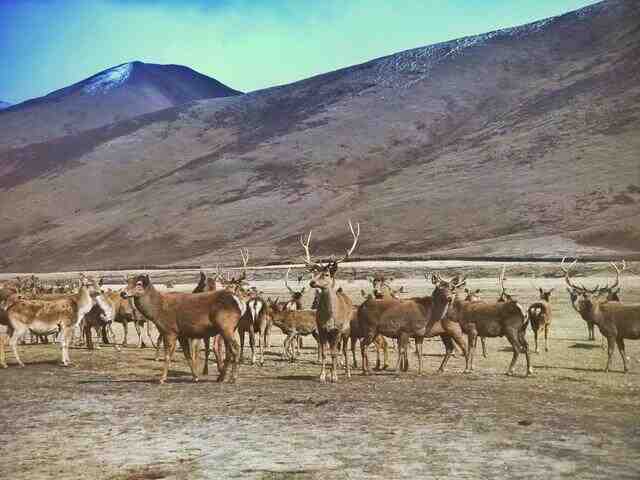Cervus elaphus wallichii
IUCN
LCBasic Information
Scientific classification
- name:Cervus elaphus wallichii
- Scientific Name:Cervus elaphus wallichii,Cervus wallichi,Cervus elaphus affinis,Cervus canadensis wallichi ,Shou Cervus, Red deer Tibetan subspecies, Red deer Tibetan subspecies, Sikkim red deer
- Outline:Ungulata
- Family:Artiodactyla S.Rumina Cervidae S.Cervidae G.Cervidae
Vital signs
- length:80-100cm
- Weight:100-120kg
- lifetime:16-18years
Feature
It is a very special member of the red deer family and is a species endemic to the Tibet Autonomous Region.
Distribution and Habitat
In China, it was once distributed in a vast area south of the Gangdise Mountains and west of the Yarlung Zangbo Grand Canyon. Records show that Tibetan red deer are only distributed in Sangri, Cona, Lhoza, and Longzi counties in Shannan City. Today, the main population of Tibetan red deer is still distributed in Zengqi Township, Sangri County, Shannan City.
Live in alpine forests or grassland areas.
Appearance
Males have horns, usually with 6 forks, up to 8 forks, with the second fork of the antlers close to the brow fork. The hair is short in summer and reddish brown throughout the body; the hair is gray-brown in winter. They live in alpine forests or grasslands. They like to live in groups. They are active at night and early morning in summer and during the day in winter. They are good at running and swimming. They feed on various grasses, leaves, twigs, bark and fruits, and like to lick salt and alkali. They mate in September and October, with a gestation period of more than 8 months, and give birth to one cub per litter.
Details
The Tibetan red deer, Shou Cervus in English, is a species endemic to the Tibet Autonomous Region. It was first discovered in Sikkim, so it is also called Sikkim red deer. .

Tibetan red deer have migratory habits. In winter and spring, they mainly move in alpine shrubs and alpine meadows at an altitude of 4,000 to 5,000 meters, feeding on the tender branches and leaves of shrubs such as alpine willow, small-leaved rhododendron, and golden wintersweet, as well as alpine meadow grass. Tibetan red deer live in groups, with an activity range of less than 10,000 square kilometers, all in mountainous areas.
Tibetan red deer in the Sangri Red Deer Nature Reserve go down the mountain in groups to drink water after dusk. Summer is here, and about a hundred Tibetan red deer form a group and slowly migrate to the mountainside. They are shedding their hair, so from behind they look like they are wearing a faded cotton jacket. At this time of year, male Tibetan red deer will lose their horns and grow new antlers, and mosquitoes on the mountain like to bite antlers. For this reason, male Tibetan red deer choose to live in high places. In the breeding season, male Tibetan red deer will prevent female deer from drinking water for two to three days in a row. When the female deer is extremely thirsty, they will go down the mountain with the female deer to drink water and complete mating.
The Tibetan red deer is a second-class protected animal in China. It was once considered extinct internationally. In 1997, a local rough count showed that there were about 2,000 red deer and white-lipped deer in the Sangri County Nature Reserve in Tibet. Now the number has increased to more than 6,000. The main natural enemies are wolves and lynxes, as well as a small number of birds of prey.
It is listed in the first level of the "List of National Key Protected Wildlife in China".
Protect wildlife and eliminate game.
Maintaining ecological balance is everyone's responsibility!








